
Synbranchiformes, often called swamp eels, is an order of ray-finned fishes that are eel-like but have spiny rays, indicating that they belong to the superorder Acanthopterygii.

The clown triggerfish, also known as the bigspotted triggerfish, is a demersal marine fish belonging to the family Balistidae, or commonly called triggerfish.

The tinfoil barb is a tropical Southeast Asian freshwater fish of the family Cyprinidae. This species was originally described as Barbus schwanenfeldii by Pieter Bleeker in 1853, and has also been placed in the genera Barbodes and Puntius. The specific epithet is frequently misspelled schwanefeldii.
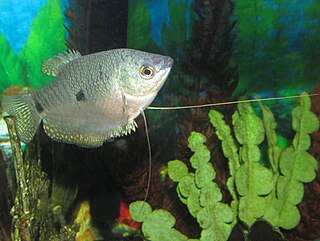
The three spot gourami, also known as the opaline gourami, blue gourami, and gold gourami, is a species of fish native to southeastern Asia, but also introduced elsewhere. This gourami gets its name from the two spots along each side of its body in line with the eye, considered the third spot. This species is of minor commercial importance as a food fish in its native range and is also farmed. It is also popular in the aquarium trade.

Polypterus senegalus, the Senegal bichir, gray bichir or Cuvier's bichir, and sometimes called the "dinosaur eel" also called "dinosaur bichir" or "dragon fish" is in the pet trade due to its lungfish-like appearance which was described as more primitive and prehistoric than other modern fishes. It is a prototypical species of fish in the genus Polypterus, meaning most of its features are held across the genus. Commonly kept in captivity by hobbyists. They are native from Africa where they are the most widespread species of the genus.

The western carp gudgeon is one of several carp gudgeon species. Carp gudgeons are very small perciform fish found in the Australian Murray-Darling River system, mainly in lowland environments, but some have been observed in upland environments. They are often found in small creeks, as well as billabongs and the edges of larger rivers. They prefer water 1 to 2 m deep with aquatic weed and structure provided by rocks or sunken timber.
The name spiny eel is used to describe members of two different families of fish: the freshwater Mastacembelidae of Asia and Africa, and the marine Notacanthidae. Both are so-named because of their eel-like shape and sturdy fin spines. These two families are not related: the Notacanthiformes belong to the Superorder Elopomorpha, whose members are characterized by having leptocephalus larvae. The freshwater Mastacembelids do not share this characteristic and are popular specimens in the aquarium trade.
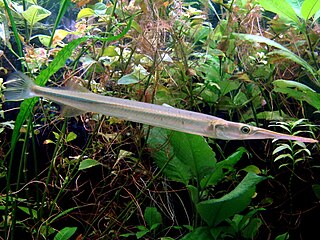
Xenentodon cancila, the freshwater garfish, is a species of needlefish found in freshwater and brackish habitats in South and Southeast Asia.

Puntigrus partipentazona, the Dwarf Tiger Barb, is a species of cyprinid fish native to Southeast Asia where it is found in the Mekong, Mae Klong, and Chao Phraya basins of Thailand, the Malay Peninsula, and coastal streams of southeast Thailand and Cambodia where it occurs in streams and impoundments with dense weed growth. It can also be found in the aquarium trade. It is frequently misidentified as the similar Puntigrus tetrazona.
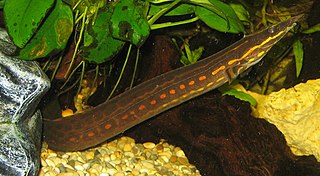
The fire eel is a relatively large species of spiny eel. This omnivorous freshwater fish is native to in Southeast Asia but also found in the aquarium trade. Although it has declined locally because of this trade and overfishing for food, it remains common overall.
Macrognathus is a genus of eel-like fish of the family Mastacembelidae of the order Synbranchiformes.
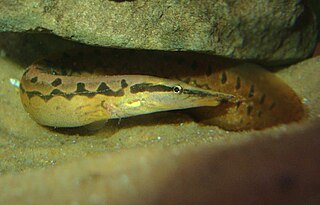
The zig-zag eel, also known as the tire-track eel, tire-track spiny eel or marbled spiny eel, is a species of ray-finned, spiny eels belonging to the genus Mastacembelus of the family Mastacembelidae, and is native to the riverine fauna of India, Bangladesh, Pakistan, Sri Lanka, Thailand, Viet Nam, Indonesia and other parts of South East Asia. The species was described as Macrognathus armatus by Lacepède in 1800. Other common names for this popular aquarium species are leopard spiny eel and white-spotted spiny eel. This species is not only a popular aquarium fish but also as a food fish in its country of origin.

Macrognathus siamensis is a tropical fish belonging to the family Mastacembelidae.

Mastacembelus ellipsifer is a species of spiny eel that is endemic to Lake Tanganyika in Africa and sometimes kept in aquariums. Although sometimes called the Tanganyikan spiny eel, it is only one of fifteen spiny eel species in the Tanganyikan basin.
The kuhli loach is a small eel-like freshwater fish belonging to the loach family (Cobitidae). They originate from Indonesia and the Malay Peninsula. This snake-like creature is very slender and nocturnal. In an aquarium, the kuhli loach can be very reclusive and, when startled, will dart underneath tank ornaments or bury itself, if a fine gravel or sandy substrate is present.
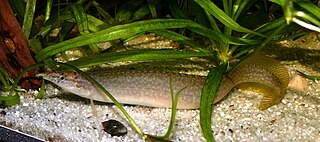
Macrognathus pancalus, the barred spiny eel or Indian spiny eel, or পাঁকাল in bengali is a small freshwater fish in southern Asia. It usually is found in slow and shallow rivers. Males are more slender and often smaller than the females.

Ophisternon bengalense the Bengal eel, Bengal mudeel or onegill eel, is a species of fish in the family Synbranchidae. It is endemic to freshwater and brackish water rivers and swamps in the Oceania and South Asia. It is normally 100 cm in maximum length.
Macrognathus aral, the one-stripe spiny eel, is a small fish from Pakistan, India, Bangladesh, Nepal and Myanmar. It usually is found in running and stagnant waters of freshwater and brackish waters. It is 63.5 cm (25.0 in) in length.
Macrognathus pentophthalmos, the Sri Lanka five-eyed spiny eel, is a small species of spiny eel that is endemic to freshwater habitats in Sri Lanka. Described as a common species as recently as 1980, for unknown reasons its population rapidly declined in the following years and there are no recent confirmed records. In 2012, it was listed as "Critically Endangered, possibly Extinct" in the Sri Lankan National Red List.
Macrognathus zebrinus, the zebra spiny eel, is a species of spiny eel endemic to Myanmar, specifically known from the Irrawaddy River, Sittaung River and Salween River and may also occur in Indonesia. It was originally described as Mastacembelus zebrinus before being moved to the genus Macrognathus in 1984 and 1986.
Jennings, Greg. (2006). 500 Freshwater Aquarium Fish. Firefly Books.















